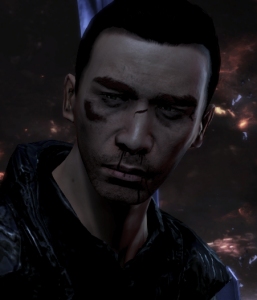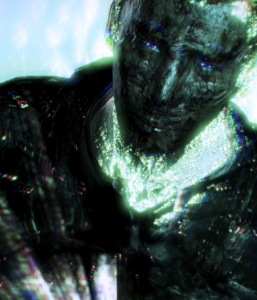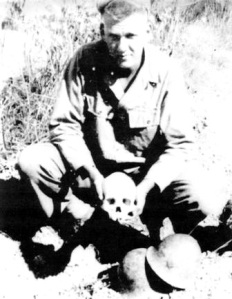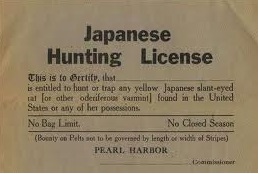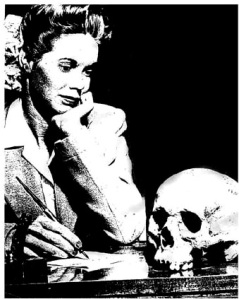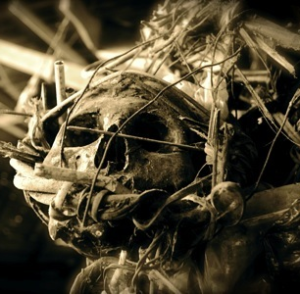Afterdeath [A Semi-Working Title]: Prolog
Dessicated remains of plants curled upon themselves as heat beat upon the cracked red earth. Great pillars of stone stretched like silent fingers toward the golden sun crossing the heavens. Stood high on one such butte was a man.
With arms clasped behind his back he surveyed the barren landscape below him. Seemingly unaffected by the heat he was clothed in a black collared shirt covered by a dark leather vest and a pair of thick denim jeans. A rust colored scarf stretched across his face and covered his head leaving only his icy blue eyes visible.
The surveying eyes abruptly stopped and locked upon a cloud of dust kicked up at the base of a nearby stone pillar. Accompanying the dust was the loud rumble of old motors carrying a merchant caravan across the devoid waste. Around another butte a second cloud of dust rose with the cry of a hundred screams as a band of horse bandits raced to head off the approaching caravan.
Silently the man watched the caravan attempt to outmaneuver and pull ahead of the horse carried bandits. His eyes darted rapidly between the two parties as he predicted their trajectories. He nodded as his internal calculations confirmed that their eventual collision and the ensuing conflict would occur just below him, at the base of the pillar on which he stood.
With a final glance the man drew from a pouch attached to his belt a black leather bound book. Cracking it open he licked his finger and thumb before calmly turning each page. Once settled upon a blank sheet he unhooked from his belt one of three ink pens and began to write. In thin strokes he wrote the names of those scrambling below followed by their date of birth and the current date.
Just as the final name was scratched into the book the caravan and the bandits collided. Yells and screams echoed off the surrounding pillars of stone. Shortly followed by the crack of gunfire and the splinter of wood. The violent sounds screamed into the ears of the man followed by the smell of wet iron from blood spilling into the parched earth.
Unperturbed the man withdrew, from the holster strapped across his broad back, a long thin iron rod. As he held it within his hands it shuddered and then rapidly elongated. From the upward end grew a curved and thinly sharpened blade. Holding the scythe slightly to the side it stretched into the sky now six feet in length.
As the chaos roared below the man then reached under his vest and pressed play on his audio device and placed a pair of headphones into his ears. An upbeat and quick rhythm filled his ears and he began to bounce his head.
“Smoke over a human’s soul. Pollutes their son’s and daughters.”
While half dancing the man approached the edge and to the beat of the tune stepped into nothing. He fell feet first like an arrow from the high pillar to the flat plain below.
“They need some dying space. Their life is being displaced.”
His boots collided heavy with the ground sending up a small dust cloud around his figure. Without missing a beat his feet set in motion as the man charged into the throes of the battle. With eyes closed he leaped into the air on an upbeat spinning in 360 degrees. His scythe stretched away from his center cut undetected through a ring of men and women crouched behind a makeshift circular barricade. It pulled from their bodies a faint glowing mist that dissipated immediately into nothing.
The caravaners continued to fire into the oncoming bandits. The unseen man landed softly on the downbeat and a bright light erupted within the circle. Bodies were rended into pieces as the grenade exploded.
“They are not gonna linger and cling on. When life is no longer coming back.”
Continuing his macabre dance the man swept his scythe through still others. All of which had a white essence pulled from within and then moments later their bodies succumbed to some manner of death.
The rhythm slowed and the song drew to a close. The man stopped dancing and squinted his eyes into the reddened afternoon sunlight. The dust had settled and nothing living within the remains of the caravan stirred. Those members still alive had been hauled away by the horseriders. In days that which had not been scavenged by the bandits would be looted by the pickers. Then in further days the landscape would reclaim its desolation and the memory of the attack would fade into oblivion.
With a grunt the man pulled the headphones from his ears stowing them away. The scythe retracted back into its rod which he secured in its holster. Without a glance to the deceased, Death walked into the West.
